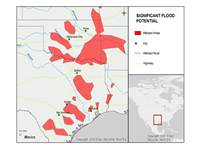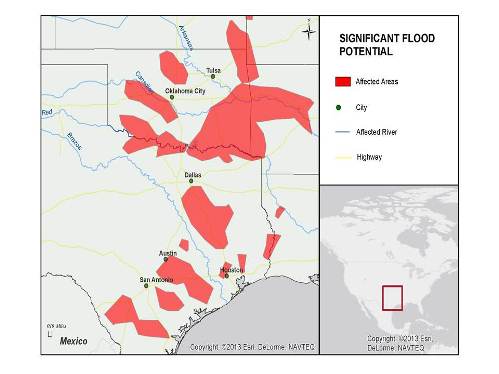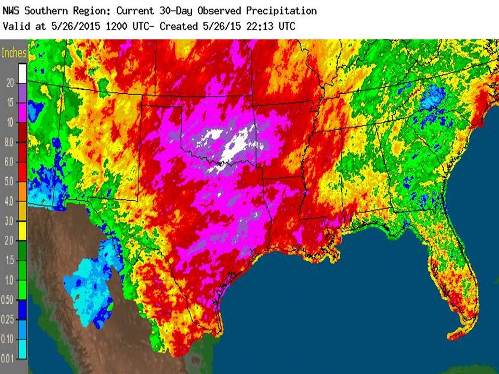

Organized thunderstorm clusters produced excessive rainfall over the Memorial Day Weekend of 2015, triggering extreme flooding in parts of Texas and Oklahoma. In Houston, Texas, 11 inches of rainfall was unofficially reported between 9 p.m. CDT Monday through 3 a.m. CDT Tuesday. Austin, Texas also experienced seven inches of rainfall.
Reports indicate severe damage as a result of rushing water and inundation, affecting homes, businesses and infrastructure over large areas that include Houston. At least 19 fatalities have been reported, with a dozen still unaccounted for. Response efforts are ongoing with both state and federal support. It will take some time to fully assess the scope and severity of impacts of this event and our first thoughts are with those lost and directly affected.

General outlook for significant flooding. Does not depict smaller flood areas. Source: U.S. National Weather Service.
Hazard data illustrated in the CAT-i map was taken from i-aXs®, Guy Carpenter’s web-based risk management platform. i-aXs users can view impacted areas on any map as well as see how their portfolios were affected. Please contact your broker or GC Analytics® representative for assistance or go to www.i-axs.info for further information.

Radar-estimated 30-day rainfall ending May 26, 12 UTC. Source: U.S. National Weather Service.

Radar-estimated 30-day percent of normal rainfall ending May 26, 12 UTC. Source: U.S. National Weather Service.
Meteorological Conditions
An organized and slow-moving cluster of thunderstorms produced excessive rainfall over southeast Texas Monday night into Tuesday morning. Rainfall rates exceeded two inches per hour for many locations, and 24-hour rainfall amounts exceeded 10 inches in Fort Bend County and Harris County, Texas. Severe flooding occurred as a result for areas in and around the Houston area.
The thunderstorms were enabled by the presence of moist, unstable air and a potent upper-level low. Upper-level mechanics were especially supportive of long-lived and slow-moving organized thunderstorm clusters (called mesoscale convective systems). The thunderstorms also produced numerous tornado and wind reports across Texas and Oklahoma.
The excessive rainfall from this and other recent events has amplified an already dangerous flood threat for watersheds in Texas and Oklahoma. Soils are already saturated from frequent heavy rain events over the last month, and many area rivers are already above flood stage. Heavy rainfall easily overwhelms local watersheds under these conditions, contributing to the ongoing flood threat. Many rivers have yet to crest following the most recent storms.
Most of Texas and Oklahoma have seen 30-day rainfall amounts exceeding normal by 200 percent, with some areas even exceeding 400 percent. Local 30-day rainfall amounts over 20 inches have been reported.
The monthly statewide rainfall average in Oklahoma has now reached 12.93 inches, breaking the previous record of 10.75 inches from October 1941. The previous monthly record for May was 10.54 inches in 1957.
Impacts
Texas
At least 15 fatalities have been reported, including at least six in Houston according to media reports. The death toll in the state is expected to rise with numerous individuals still reported missing.
While damage assessment reports are preliminary, officials expect severe damage to infrastructure and communities. According to reports, thousands of homes have sustained damage, while approximately 2,500 vehicles have been abandoned on Houston roadways. Firefighters in the area carried out more than 500 rescues, with the majority involving stranded motorists.
More than 100,000 gallons of untreated wastewater spilled at a wastewater treatment plant in Houston due to electrical and mechanical damage from flooding. The spill has been contained and cleanup is expected to start once flooding subsides. At Houston and Dallas airports, at least 200 flights have been cancelled as of 12 p.m. CDT Wednesday.
In the city of San Marcos, nearly 1,000 homes were damaged due to flooding from the Blanco River according to media reports.
President Barack Obama has promised federal aid as the state recovers from the floods. Texas Governor Greg Abbott declared a state of disaster in at least 40 Texas counties, including Harris County and the City of Houston. Roughly 100,000 customers lost power throughout the state after the storm due to high winds and rising waters that caused power poles to snap.
Oklahoma
At least 4 fatalities have been reported. Media reports indicate significant damage to public infrastructure including roads and bridges across the state from excessive rainfall and flooding this month. Numerous properties have been affected.
Dozens of state highways were closed on Tuesday in 20 counties from central and northern Oklahoma to the borders of Texas and Arkansas.
Sources: Reuters, Associated Press, Wall Street Journal, U.S. National Weather Service.
Guy Carpenter publishes CAT-i reports for major natural catastrophes worldwide. These reports cover catastrophes including worldwide tropical cyclones, earthquakes, major UK and European floods and any other natural event that is likely to incur a significant loss to the (re)insurance industry. Please email mailto:CAT.i@guycarp.com if you wish to be added to the free email distribution list.
Guy Carpenter compiles RISK-i reports for major technological or man-made events worldwide. These reports cover risks to property, transport and life including explosions, fires, crashes, engineering disasters and terrorist attacks that are likely to incur a significant loss to the (re)insurance industry. Please email RISK.i@guycarp.com if you wish to be added to the free email distribution list.